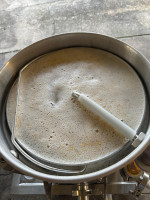Mash Guidelines
|
Amount
|
Description
|
Type
|
Start Temp
|
Target Temp
|
Time
|
|
7.5 gal |
Mash-In (Overnight) |
Infusion |
75 °F |
154 °F |
75 min |
|
|
Mash Out |
Vorlauf |
154 °F |
168 °F |
10 min |
Starting Mash Thickness:
3.2 qt/lb
Starting Grain Temp:
80 °F |
Yeast
|
Escarpment Labs - Escarpment Labs - Escarpment Labs - House Ale
|
|
Amount:
|
1 Each |
Cost:
|
|
|
Attenuation (custom):
|
80%
|
Flocculation:
|
Medium |
|
Optimum Temp:
|
61 - 72 °F |
Starter:
|
No |
|
Fermentation Temp:
|
68 °F
|
Pitch Rate:
|
0.75 (M cells / ml / ° P)
237 B cells required
|
|
|
$ 0.00
Yeast Pitch Rate and Starter Calculator
|
Priming
|
Method: co2
Amount: 27.96 psi
Temp: 68 °F
CO2 Level: 2.52 Volumes |
Target Water Profile
American Amber Ale
| Ca+2 |
Mg+2 |
Na+ |
Cl- |
SO4-2 |
HCO3- |
|
125 |
10 |
32 |
130 |
194 |
43 |
MINERAL SALTS
For 7.5 gal RO water, the amount to add is:
5.5 g CaCl2
1.0 g NaCl
3.5 g Epsom Salt
9.5 g Gypsum
1.75 g Baking Soda
|
|
Mash Chemistry and Brewing Water Calculator
|
Notes
An American Amber Ale that borders on the edge of a Red IPA.
Adapted from the recipe "Left on Red" by The Apartment Brewer.
PRE-BREW DAY PLANNING
Use Brewer's Friend checklist.
YEAST
Yeast is Escarpment Labs EL-D1 House Ale yeast, a dry yeast from Guelph, Ontario, Canada. A proper hydration needs to be done, maybe an hour or more before pitching.
MASHING
Mash in at 154° F. Stir rapidly. After all is combined very well, allow to rest about 10 min, then measure pH. If it is higher than 5.45, add acid to adjust.
.....PROCEED WITH MASHING (Choose one method).....
OVERNIGHT MASH
Once temperature is stabilized at 154° F, set power for heating element at 60% power. Set Brew Commander to sustain this temperature overnight, then allow mash to continue overnight. DO NOT TURN ON THE PUMP NOW! Recirculation should be started in the morning.
The next morning...
Around 8:30 am, record the temperature shown by the Brew Commander. Now, stir the mash, see if temperature changes. Record this temperature to compare with mash temperature shown before mash was stirred.
Open all valves that.need to be opened, and begin recirculation.
Stir the mash. Measure pH after 10 min in, and add acid if necessary. Check the pre-boil gravity to determine that it is near or at 1.058.
Increase power to 85% and ramp-up to 168° F for the mash-out/vorlauf. Mash-out is of 15 minute duration.
REGULAR MASH
Mash for 75 minutes at 154° F, checking pH and gravity to determine if it is necessary to mash longer than 75 minutes. Pre-Boil Gravity should be at or near 1.058. Check pH, and adjust if needed. If gravity is not at or near 1.058, mash longer.
Add dark grain late addition grains with about 10 minutes remaining.
MASH OUT
Increase power to 85% and ramp-up to 168° F for the mash-out/vorlauf. Mash-out is of 15 minute duration.
RAISING THE GRAIN BASKET
Turn off recirculation. Raise the grain basket and hang on side of kettle as usual.
Turn off valves, making sure the 3-way whirlpool valve is open only on the RIGHT side, not the mash recirculating side. Remove small hose from recirculation flow meter, and allow to empty into a vessel, then put liquid back in kettle. Connect long recirculation hose to left side of 3-way valve.
RECIRCULATION OVER GRAINS
Secure recirculation hose over grain basket using a clamp. Now, open 3-way valve to center position. Start recirculation, regulating flow rate through pump exit valve. Allow to recirculate over grains for 15 minutes at a moderate flow rate.
DRAINING GRAIN BASKET
Adjust 3-way valve so recirculation valve (left side) is closed. Remove long recirculation hose and allow to drain into vessel, then return liquid to kettle.
Allow grain basket to drain for 15 minutes, then remove basket and hang over bucket to catch remaining fluid draining. In the meantime, allow whirlpool recirculation to proceed as liquid ramps up to a boil. When draining is complete, add remaining liquid to kettle.
RAMPING UP TO A BOIL
Turn off pump, shut off all valves, then MAKE SURE BREW COMMANDER IS SET IN BOIL MODE. Set power at 85-95%. Drain all hoses into bucket, then collect sample for measuring OG, pH, etc. Put remaining liquid in kettle. Continue with ramp up to boil.
BOILING
(This is a good time to hydrate the yeast. Use bottled water at 85° F).
When boiling commences, cut power to 50%. If it is at the lowest point of what would be a "rolling" boil, keep it at this level. If it needs to be lowered, do that. When boiling is at the acceptable level, put the lid with the Steam Slayer on top in place, then start the water flowing through the condenser. The condenser drain hose goes into a bucket. Have 3 buckets ready for use, so when one fills up, another can be put in its place.
Be ready with the various additions to be put In at the specified time (hops, yeast nutrients, Irish Moss, etc.). Add these as indicated in the recipe.
At the end of the boil, remove all the bags of boiling and finishing hops.
Evaporation rate should be only 0.5 gal in 90 min, due to use of the Steam Slayer steam condenser device.
WORT CHILLING
Chill to whirlpool temperature (165° F). Turn off chilling water at around 178° f, and allow to drop on its own to 165° deg F.
Step 2 - Addition of whirlpool hops (for aroma and some flavor). All whirlpool hops should be added at this time. Continue to recirculate for 15 minutes. Do NOT remove the bags of whirlpool hops at the end.
TRANSFER TO FERMENTER/OXYGENATION
Use oxygenation system to add O2. As wort begins to enter the fermentor, add Zinc Buddy. When it's about halfway full, add one vial of the BrewZyme D (prevents diacetyl formation)
PITCHING YEAST
Pitch the hydrated Escarpment Labs House Ale yeast into the fermentor. Rock the fermentor to assure even distribution of the yeast. Make sure the Tilt Hydrometer is in there.
FERMENTATION
Allow fermentation to proceed at a steady 68° F. it will take 5 days or so for fermentation to complete. When the final gravity measurement is as low as it will go, it's time to COLD CRASH. Cool down to around 35° deg F, then add the 2 oz Cascade dry hops. Allow to sit for 5 days.
PACKAGING
Force carbonate TO 2.5 volumes.

Last Updated and Sharing

- Public: Yup, Shared
- Last Updated: 2025-11-12 14:12 UTC
- Snapshot Created: 2025-10-25 14:48 UTC
For quick copying and pasting to a text based forum or email.
Click the Download as HTML file button below.
Recipe costs can be adjusted by changing the batch size. They won't be saved but will give you an idea of costs if your final yield was different.
|
Cost $ |
Cost % |
| Fermentables |
$ |
|
Steeping Grains
(Extract Only) |
$ |
|
| Hops |
$ |
|
| Yeast |
$ |
|
| Other |
$ |
|
| Cost Per Barrel |
$ 0.00 |
|
| Cost Per Pint |
$ 0.00 |
|
| Total Cost |
$ 0.00 |
|
Discussion about this recipe:
